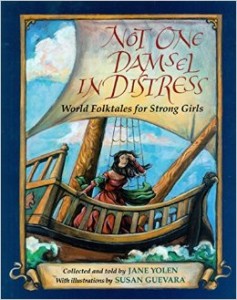 Marian McHugh penned this review.
Marian McHugh penned this review.
Yolen initially compiled Not One Damsel in Distress for her daughter and three granddaughters, as she wished to provide for her girls that which she had not been able to access — stories where girls are the heroes. Not heroines or sheroes but true heroes, in every sense of the word. Stories where it is the girls who are the knights and the serpent slayers and the pirates. As Yolen writes in the open letter to her girls at the beginning of the collection, “This book is for you because in it are folktales about heroes — regular sword-wielding, spear-throwing, villain-stomping, rescuing-type heroes who also happen to be females.”
The first story — “Atalanta the Huntress” — tells the story of a girl left in the woods by her father, the king. She is found and cared for by a bear till the age of three, then she is taken in by a hunter and his wife. She learns the ways of the wood and becomes a great huntress. At the death of her stepparents she calls upon Artemis, goddess of the hunt, to aid her and is told, “Disaster will follow the men you meet.” Upon hearing this, she vows to avoid men, easier said than done, especially when one is a hunter.
Eventually her fame is made known to the king and as he has no heir he asks her forgiveness — however, he expects her to marry. She tells him that she will only marry a man who can beat her at a footrace, not an easy accomplishment. Along comes Prince Melanion, who is smitten with love for Atalanta. He asks Aphrodite, goddess of love, to give him assistance. She provides him with three golden apples, which he uses to win the race, and the hand of Atalanta.
“Burd Janet” is the retelling of “Tam Lin,” a popular Scottish ballad, which comes to us through the Child Ballads. It is the story of Janet, daughter of the clan chief, who declares that when she is old enough she will claim Carterhaugh as her own. Carterhaugh is a forbidding castle that children are warned not to go near as it is in the possession of the faeries. Being a em-willed child, this Janet did on her sixteenth birthday. It is while she is claiming the castle as her rightful inheritance that she meets Tam Lin, a boy who had been lost to the mortal world three generations earlier. The queen of the Fair Folk plans to sacrifice Tam Lin as a teind to Hell on All Hallows Eve, but Janet vows to save him.
“Bradamante” is the name of the knight of “the white plume and shield” who fought in the time of Charlemagne and just happened to be a woman. There are many stories about the exploits of Bradamante, and here Yolen retells two. The first tells of Bradamante’s friendship with Ruggiero, a Moorish prince who should be her sworn enemy. The second story involves Bradamante’s rescue of Ruggiero from the magician who raised him and kept him hostage.
The stories have been collected from all around the world and include those from Africa, South America, North America, Japan, Europe and the British Isles. As with her other collections, Yolen has provided the reader with detailed information regarding the sources of her retelling of the tales, as well as a comprehensive bibliography. This will be much appreciated by those who like to trace the origins of folktales.
Not One Damsel in Distress contains a variety of different folktales, which complement each other. Each tale shows that females can be heroes, and that, just as with males, there are many different types of heroes, ranging from Bradamante, the knight in shining armour, to Atalanta the hunter. I look forward to reading these stories to my own children, regardless of their gender, and hope that others will share our enjoyment.
If you enjoy reading the stories in Not One Damsel in Distress you might also enjoy Kathleen Raglan’s Fearless Girls, Wise Women and Beloved Sisters: Heroines in Folktales from Around the World.
More information about Jane Yolen and her many writings can be found at her Web site.
